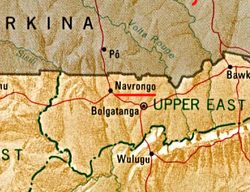Navrongo
Navrongo | |
|---|---|
 Location of Navrongo. Navrongo is in the north east of Ghana, beside the Burkina Faso border. | |
| Country | |
| Region | Upper East Region |
| District | Kassena-Nankana District |
| Population (2012) | |
• Total | 27,306[1] |
| Ranked 56th in Ghana | |
| Time zone | GMT |
| • Summer (DST) | GMT |
Navrongo is a town in Ghana, near its northern (Burkina Faso) border. It is the capital of Kassena-Nankana District – which is within the Upper East Region of Ghana. Navrongo is the fifty-sixth most populous in Ghana, in terms of population, with a population of 27,306 people.[1]
Navrongo is an important market town, known for its cathedral and its grotto.
Navrongo is located at 10°53′5″N 1°5′25″W / 10.88472°N 1.09028°W. Its population in 2005 was estimated to be 25,470.[2] The terrain is flat and the ecology is typical of the Sahel – arid grassland with occasional shrubbery.
People and history
The people of Navrongo are a mixture of Nankani speakers from Zecco in what is now Burkina Faso, and Kassena Kasem speakers from Tielebe (also in Bukina Faso). The Kassena arrived first in the area, whilst the Nankani arrived later after experiencing pressure from Mossi expansion. The two groups, though they differ linguistically, share many cultural traits.
The town was founded around 1740.[3] During the 19th century, the town became an important staging post on the Sahel caravan route. The wealth associated with this route encouraged fighting for control between the different ethnic groups of the area. At the beginning of the 20th century the British established a base at Navrongo. The town was "civilised by force of arms",[4] and inter-ethnic conflict declined.
Chiefs loyal to the British were installed and "free labour" was used to build roads and government buildings. Locals were also sent to the south of Ghana to mine and build railways.
A Catholic mission was established in 1906 - the White Fathers ("Pères Blancs"), a French group made up of French Canadians. They came to Ghana from Upper Volta (now Burkina Faso) due to French anti-clerical laws (the Fathers believed they would be expelled from Upper Volta). The British allowed them to set up in Navrongo on condition that the school that they were to establish used English only. Despite a rocky beginning (the Fathers had learnt the wrong local language and only attracted 5 students in the first 18 months), the school eventually became a success – a British official in 1927 said that is was the best school (of only 5) in the north of Ghana.[5]
The population is now split fairly evenly between the Kassena and the Nankani speakers. Indigenous African beliefs are followed by the majority. Around a third are Christians, while 5% follow Islam. Like other people in the Sahel region, levels of both fertility and mortality are high. Partly because of this, a health research centre has been established in the area, with some success.
Subsistence level agriculture is the usual occupation of the area, as well as the rearing of goats and cattle.
The Nakana people are part of the Mole-Dagbani language group and in the great time of the Mossi-Dagomba states formed part of the chiefship of Tongo and adjacent Nangodi.
Navrongo Cathedral
Navrongo Cathedral, as it is now known, was built in 1906 and expanded in 1920. Originally called "Our Lady of Seven Sorrows", the construction was overseen by the White Fathers. The walls are of mud (therefore it is also called "Mud Cathedral"), and wooden beams form the roof. On the inside, the walls are decorated with animal forms, scenes of everyday life, and Christian themes such as the Last Supper and the Bethlehem scene in the entrance area. The site also contains a grotto and accommodation facilities. For copious images and content, see Navrongo Cathedral.
Etymology of name
The word "Navrongo" is an Anglicization of the town's Nankani (a dialect of Frafra) name navorlngo. This in turn comes from its Kasem [1] name navoro, which combines the word naga (meaning foot or leg) with voro (meaning the sound of stepping onto crunchy, dry soil).[6]
References
- ^ a b "World Gazetteer online". World-gazetteer.com.
- ^ "2005 population estimates for cities in Ghana". Retrieved 2007-09-26.
- ^ Adewoba. 'Aspects of Wealth and Exchange'.
- ^ Arhim. 'The Papers of George Ferguson'.
- ^ Kimble. 'A political history of Ghana'.
- ^ St. John-Parsons, Donald. 'Legends of Northern Ghana'.
External links
- Navrongo and Lawra homepage — site which details the history, music, and culture of Navrongo. Set up by Peace Corps volunteers.
- Navrongo Health Research Centre — a Ghana Health Service research centre based in Navrongo.
- MSN Map
The president recently commissioned the first ever 2MW solar plant


















